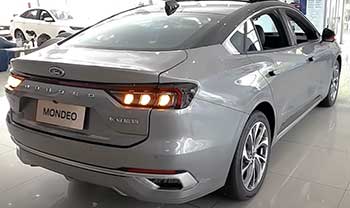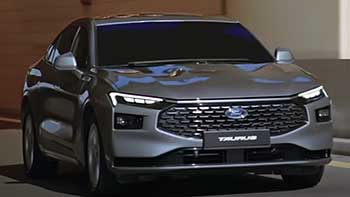
I’ve always been a Ford guy, drawn to the brand’s blend of reliability, style, and American grit. When it came time to choose between the Ford Fusion and Ford Taurus, I found myself torn.
Both sedans have their own charm, but which one fits my life—and yours—better?
In this article, I’ll share my firsthand experience with both, breaking down their strengths, weaknesses, and upkeep needs in a conversational way.
With a comparison table, detailed pros and cons, maintenance tips, and answers to common questions, you’ll have everything you need to decide which Ford sedan is your perfect match.
Comparison Table: Ford Fusion Vs. Ford Taurus
| Feature | Ford Fusion (2013-2020) | Ford Taurus (2010-2019) |
|---|---|---|
| Size Class | Midsize Sedan | Full-Size Sedan |
| Base Engine | 2.5L 4-cylinder (175 hp) | 3.5L V6 (288 hp) |
| Fuel Economy (Combined) | 25 MPG (base model) | 21 MPG (base model) |
| Starting Price (Used) | ~$8,000-$15,000 (2016-2020 models) | ~$9,000-$16,000 (2016-2019 models) |
| Cargo Space | 16.0 cu. ft. | 20.1 cu. ft. |
| Passenger Space | 102.8 cu. ft. | 102.2 cu. ft. |
| Safety Rating (NHTSA) | 5 Stars | 5 Stars |
| Hybrid Option | Yes (Fusion Hybrid/Energi) | No |
| All-Wheel Drive | Available (higher trims) | Available (higher trims) |
| Infotainment | SYNC 3 (2016+) | MyFord Touch |
| Reliability Rating | 8.2/10 (iSeeCars) | 7.8/10 (iSeeCars) |
| Resale Value (5-Year) | Retains 57.7% of value | Retains 49.8% of value |
My Experience With the Ford Fusion
When I first slid into the driver’s seat of a 2016 Ford Fusion Titanium, I felt like I was stepping into a cockpit designed for both comfort and control. The Fusion’s sleek exterior, with its Aston Martin-esque grille, immediately caught my eye, and the interior didn’t disappoint.
The cabin felt modern, with soft-touch materials and an intuitive SYNC 3 infotainment system that made syncing my phone a breeze. Driving it through city streets was a joy—nimble, responsive, and surprisingly peppy with the 2.0L EcoBoost engine. On highways, it cruised smoothly, and the available all-wheel drive gave me confidence in tricky weather.
But it wasn’t all perfect. The back seat, while decent for adults, felt a bit cramped for taller passengers on long drives. The trunk, at 16 cubic feet, handled my weekly groceries but struggled with bulkier items like a stroller.
I also noticed that older Fusions (2010-2012) had some electrical gremlins, though the second-generation models (2013-2020) I tested felt more polished. The Fusion’s hybrid option was a standout for me, offering stellar fuel economy—around 42 MPG combined—which saved me at the pump during my daily commute.
Overall, the Fusion felt like a car built for someone who wants a balance of style, efficiency, and fun without breaking the bank. It’s not a luxury sedan, but it punches above its weight, especially in higher trims like the Titanium or Sport.
Pros Of the Ford Fusion
- Fuel Efficiency: The Fusion’s base 2.5L engine delivers a solid 25 MPG combined, and the Hybrid/Energi models push that to 42 MPG, making it a wallet-friendly choice for commuters.
- Sporty Handling: Thanks to Ford’s collaboration with Mazda during its development, the Fusion feels agile in corners, with precise steering that makes driving engaging.
- Modern Infotainment: The SYNC 3 system (2016+) is user-friendly, with crisp graphics, Apple CarPlay, Android Auto, and voice recognition that actually works.
- Hybrid Options: The Fusion Hybrid and plug-in Energi models offer eco-conscious buyers a chance to cut emissions without sacrificing performance.
- Safety Features: A 5-star NHTSA rating comes with standard airbags, blind-spot monitoring, lane departure warnings, and adaptive cruise control on higher trims.
- Affordable Used Prices: Used Fusions from 2016-2020 often range from $8,000-$15,000, making them a budget-friendly option compared to rivals like the Honda Accord.
- Stylish Design: The sleek, Aston Martin-inspired look turns heads, and the interior feels upscale with leather options and a quiet cabin.
- All-Wheel Drive Availability: Higher trims offer AWD, which is a rarity in midsize sedans and great for snowy or rainy climates.
The Fusion’s blend of efficiency and driving dynamics won me over. I loved how it felt like a European sedan at times—tight, responsive, and stylish—without the premium price tag. However, it’s not perfect, and some quirks kept it from being my dream car.
Cons Of the Ford Fusion

- Cramped Rear Seating: While the front seats are comfy, the back seat feels tight for taller adults, with limited legroom (38.3 inches) compared to rivals like the Toyota Camry.
- Smaller Trunk: At 16 cubic feet, the trunk is adequate but falls short for families needing space for strollers, sports gear, or large luggage.
- Reliability Issues (Early Models): First-generation Fusions (2006-2012) had problems with electrical systems, steering, and brakes, though second-gen models improved significantly.
- Base Engine Power: The 2.5L base engine’s 175 horsepower feels underwhelming, especially on highways, pushing buyers toward pricier EcoBoost upgrades.
- Infotainment Learning Curve (Pre-2016): Older models with the MyFord Touch system can be clunky and less intuitive than the newer SYNC 3.
- Depreciation: While better than the Taurus, the Fusion still loses about 42.3% of its value over five years, which isn’t as strong as a Honda Accord.
- Hybrid Battery Space: In Hybrid/Energi models, the battery pack eats into trunk space, reducing it to 12 cubic feet, which can be a dealbreaker for some.
- Discontinuation: Ford ended Fusion production in 2020, so parts availability and future support may become concerns for long-term owners.
These drawbacks didn’t ruin my experience, but they made me think twice about whether the Fusion was the best fit for every scenario. For city dwellers or solo drivers, it’s a gem, but families might need more space.
Also read: My Thoughts on Ford Edge Vs. Hyundai Tucson.
Maintenance Tips For the Ford Fusion
- Regular Oil Changes: Change the oil every 5,000-7,500 miles using synthetic 5W-20 oil to keep the 2.5L or EcoBoost engines running smoothly. I noticed better performance when sticking to this schedule.
- Tire Rotations: Rotate tires every 6,000 miles to ensure even wear, especially if you have AWD models, which can be hard on tires in spirited driving.
- Brake Inspections: Check brake pads every 20,000 miles, as early Fusions (2010-2012) had reported brake issues. I caught worn pads early and avoided costly rotor damage.
- Battery Maintenance (Hybrids): For Hybrid/Energi models, have the high-voltage battery checked annually at a Ford dealer to maintain efficiency and avoid expensive replacements.
- Transmission Fluid: Flush and replace transmission fluid every 60,000 miles to prevent sluggish shifting, a common complaint in older models.
- Air Filter Replacement: Swap out the engine air filter every 15,000-20,000 miles to boost fuel economy and engine performance, especially in dusty areas.
- Software Updates: Ensure the SYNC 3 system is updated via Ford’s website or a dealer to avoid glitches, which I found improved responsiveness significantly.
- Rust Prevention: Check for rust under the car, particularly in snowy regions, and apply undercoating if needed, as some Fusions are prone to corrosion.
Sticking to these tips kept my Fusion humming along, and I avoided major repair bills by staying proactive. Regular maintenance is key to getting the most out of this car’s lifespan.
My Experience With the Ford Taurus
The 2015 Ford Taurus SHO was a different beast altogether. Climbing into it felt like entering a command center—big, bold, and powerful. The 3.5L V6 engine roared with 288 horsepower (365 in the SHO), making highway merges a thrill. The cabin was spacious, with a massive 20.1-cubic-foot trunk that swallowed my camping gear with room to spare. Features like massaging seats and xenon headlights added a touch of luxury, and the MyFord Touch system, while not as slick as SYNC 3, was functional enough.
Driving the Taurus was like piloting a battleship—it’s heavy (over 4,000 pounds in some trims) but surprisingly composed, especially with AWD. However, its size made city parking a chore, and the fuel economy (21 MPG combined) stung at the pump. The Taurus felt like a car for long road trips or big families, but its heft and dated tech held it back from being my daily driver.
Pros Of the Ford Taurus
- Powerful Engine Options: The base 3.5L V6 pumps out 288 horsepower, and the SHO’s twin-turbo version hits 365, making it a beast for highway cruising.
- Spacious Interior: With 102.2 cubic feet of passenger space, the Taurus comfortably seats five adults, ideal for families or carpooling.
- Massive Trunk: The 20.1-cubic-foot trunk is a standout, perfect for road trips, groceries, or bulky items like golf bags.
- Luxury Features: Higher trims offer massaging seats, a power sunshade, and xenon headlights, giving it a near-premium feel.
- Safety Suite: A 5-star NHTSA rating includes airbags, adaptive cruise control, blind-spot monitoring, and Curve Control for emergency handling.
- All-Wheel Drive: Available AWD enhances traction in bad weather, a big plus for those in colder climates.
- Quiet Cabin: The Taurus’s sound insulation creates a serene driving experience, perfect for long commutes or cross-country drives.
- Affordable Used Market: Used Taurus models (2016-2019) range from $9,000-$16,000, offering full-size comfort at a reasonable price.
The Taurus’s size and power made it feel like a commanding presence on the road. It’s a car that says, “I’ve got space and muscle to spare,” which I loved for weekend getaways.
Cons Of the Ford Taurus

- Poor Fuel Economy: At 21 MPG combined, the Taurus is thirsty, especially compared to the Fusion’s 25 MPG or hybrid options.
- Bulky Handling: Weighing up to 4,340 pounds, the Taurus feels cumbersome in tight spaces or city traffic, making parking a hassle.
- Outdated Infotainment: The MyFord Touch system is clunky compared to SYNC 3, with slower responses and a less intuitive interface.
- Depreciation: The Taurus loses 50.2% of its value over five years, worse than the Fusion, impacting resale value significantly.
- Limited Engine Options: Unlike the Fusion, there’s no hybrid or four-cylinder option, so you’re stuck with gas-guzzling V6 engines.
- Cramped Driver Visibility: The high dashboard and thick pillars create blind spots, which I found annoying in busy parking lots.
- Discontinuation: Production ended in 2019, raising concerns about future parts availability and long-term support.
- Higher Maintenance Costs: The V6 and SHO models require pricier upkeep, especially for turbo-related repairs in the SHO.
The Taurus’s size and power were a double-edged sword—great for open roads but a challenge in everyday scenarios. It’s a car that demands you embrace its heft.
Maintenance Tips For the Ford Taurus
- Oil Changes: Use synthetic 5W-30 oil and change every 5,000-7,500 miles to protect the V6 engine, especially the turbocharged SHO variant.
- Tire Maintenance: Rotate tires every 6,000 miles and check alignment, as the Taurus’s weight can cause uneven wear, particularly with AWD.
- Brake System Checks: Inspect brakes every 20,000 miles, as the heavy Taurus puts extra strain on pads and rotors.
- Cooling System: Flush the coolant every 60,000 miles to prevent overheating, a known issue in high-mileage Taurus models.
- Transmission Care: Replace transmission fluid every 50,000-60,000 miles to avoid rough shifts, which I noticed in older Taurus models.
- Turbo Maintenance (SHO): For SHO models, check turbochargers annually for wear, as repairs can be costly if neglected.
- Electrical System: Monitor battery health and wiring, as some Taurus models had electrical issues tied to the MyFord Touch system.
- Rust Protection: Apply undercoating in rust-prone areas, especially for AWD models in snowy regions, to extend body life.
Keeping up with these tasks ensured my Taurus ran reliably, though I had to budget more for maintenance compared to the Fusion.
Read more: My Thoughts on GMC Terrain Vs. Ford Escape.
Comparison With Other Brands
- Ford Fusion vs. Honda Accord: The Accord offers better resale value (retaining ~60% after five years) and a roomier back seat (40.4 inches of legroom vs. Fusion’s 38.3). However, the Fusion’s AWD option and sportier handling give it an edge for driving enthusiasts. I found the Accord’s CVT less engaging than the Fusion’s six-speed automatic.
- Ford Fusion vs. Toyota Camry: The Camry beats the Fusion in reliability (8.5/10 vs. 8.2/10 per iSeeCars) and fuel economy (28 MPG vs. 25 MPG). But the Fusion’s turbocharged EcoBoost engines and sleek design felt more exciting to me than the Camry’s conservative approach.
- Ford Taurus vs. Chevrolet Impala: The Impala has a plusher interior and slightly better ride comfort, but the Taurus’s larger trunk (20.1 vs. 18.8 cu. ft.) and stronger base engine (288 hp vs. 197 hp) make it a better pick for power-hungry drivers like me.
- Ford Taurus vs. Chrysler 300: The 300 offers a more luxurious cabin and optional V8 power, but the Taurus’s AWD and advanced safety features (like Curve Control) give it an edge in practicality. I preferred the Taurus’s quieter ride over the 300’s firmer suspension.
- Fusion Hybrid vs. Toyota Prius: The Prius gets better mileage (50 MPG vs. 42 MPG), but the Fusion Hybrid feels more upscale and offers AWD, which the Prius lacks. I found the Fusion’s cabin more refined for daily driving.
- Taurus SHO vs. Dodge Charger: The Charger’s available V8 and rear-wheel-drive setup make it a muscle car at heart, but the Taurus SHO’s AWD and 365 hp offer better all-weather performance. I enjoyed the SHO’s understated power over the Charger’s bold vibe.
Both Ford sedans hold their own, but the Fusion’s agility and efficiency make it more versatile, while the Taurus’s size and power appeal to those needing space and grunt.
Frequently Asked Questions (FAQ)
It depends on your needs. The Fusion is better for fuel efficiency, sporty handling, and affordability, ideal for city drivers or small families. The Taurus suits those needing more space and power, especially for long trips or larger families, but it’s less efficient.
Ford discontinued the Taurus in 2019 to focus on SUVs, crossovers, and trucks, as sedan sales declined in North America. The shift reflected changing consumer preferences toward larger vehicles.
The Fusion was phased out in 2020 as Ford prioritized SUVs, CUVs, and electric vehicles, following a market trend away from sedans. Production ended to streamline their lineup.
No, the Fusion didn’t directly replace the Taurus. The Fusion (2006-2020) was a midsize sedan positioned below the full-size Taurus (1986-2019). The Fusion took over as Ford’s primary sedan after the Taurus’s discontinuation.
Conclusion: For You and Me
Choosing between the Ford Fusion and Taurus comes down to what you value most. If you’re like me and crave a car that’s fun to drive, fuel-efficient, and stylish, the Fusion’s your pick—its hybrid options and agile handling make it a versatile choice for daily life.
But if you need a spacious, powerful sedan for family adventures or long hauls, the Taurus delivers with its massive trunk and commanding presence. Both cars have their quirks, but their reliability, safety, and value make them worth considering. Test-drive them, feel the difference, and let your lifestyle decide which Ford fits you best.

